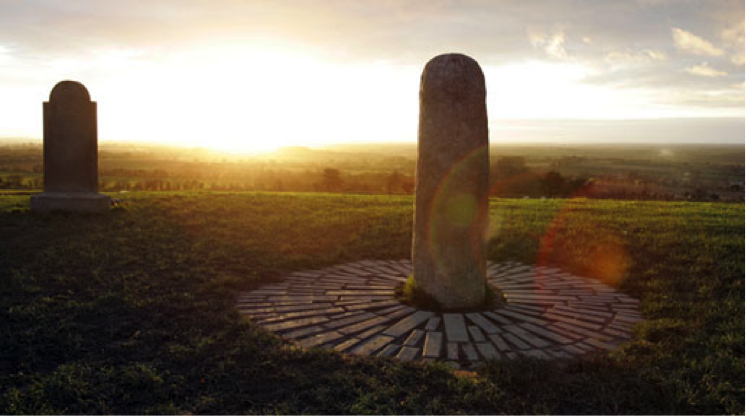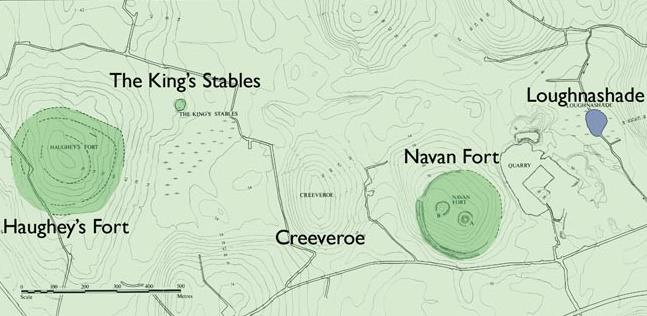Irish mythology is a fascinating subject in its own right. In Castle Gillian we have references to specific mythologies as they pertain to the plot of the story. That said, Castle Gillian is not a fantasy musical, rather a romance adventure story. So there are no leprechauns, per se, but the little people do get a mention in one of the climactic scenes in this musical adaptation.
Ireland, for those who have had the joy of experiencing it, is a land rich with mystery and myth, intriguing sites and stories. On a separate page we take a look at Irish Castles.
Following is an illustrative description of some of the major locations worth visiting; either virtually or, even better, in-person should you be fortunate to do so.
The Boyne Valley: Newgrange, Knowth, Dowth, Hill of Tara & Hill of Slane, Co. Meath
Brú na Bóinne (Palace of the Boyne) spreads over Counties Meath and Louth. The Boyne Palace contains some of the most important historic sites and monuments in Ireland, including the massive, ancient passage tombs of Newgrange, Knowth and Dowth, the pagan headquarters of the Hill of Tara and the legendary Hill of Slane.
Newgrange
Newgrange is Ireland’s most famous prehistoric site. As with most of the passage tombs in Ireland, archeologists believe that it was built around 3200 B.C., which means that Newgrange predates the construction of Stonehenge in England and the Pyramids in Egypt.
Newgrange was built so that during the winter solstice (dawn on the shortest day of the year), a narrow beam of sunlight illuminates the floor of the chamber at the end of the long passageway for about 17 minutes.
Celtic myth says that Newgrange is a fairy mound, or a sidh. A group of ancient people, the Tuatha Dé Danann, or “people of the goddess Danu,” dwelled there. Newgrange was built by the god Dagda and named for the goddess Boann.
Some say that the famous Irish mythological hero Cuchulainn was conceived in Newgrange.
Access to Newgrange begins at a visitors’ center, from where you can take a guided tour of the site. The center hosts a re-enactment of the winter solstice at Newgrange through the use of electric lights situated within the tomb. A lottery is held annually for tickets to be allowed into the tomb during the actual event.
The Great Mound at Knowth
Knowth is the second of the three major passage tombs in the Boyne Valley. Built over 5,000 years ago, the mound is younger than Newgrange, but older than Dowth. Knowth is similar in size to Newgrange.
The mound has two passages (unlike Newgrange, which has one), with entrances on the east and west sides. Recent scientific data says suggests Knowth had a lunar function when it came to ancient rituals.
Knowth is best known for its impressively large collection of stones carved with Neolithic art, which comprises a quarter of all known Neolithic art in Europe.
It is said that a noblewoman named Bua is buried at Knowth, and a “great hill” was built up over her, creating the Great Mound at Knowth.
Hill of Tara
The Hill of Tara, also in the Boyne Valley, is the ancient seat of power in Ireland, and contains over 30 visible ancient monuments, including the Stone of Destiny and the Mound of the Hostages.
The Hill is said to be the actual seat of the High Kings of Celtic Ireland and the sacred dwelling place of the gods.
It is believed that St. Patrick went to Tara – the most powerful Celtic pagan site – in order to confront the religion of the Celtic pagans.
One of the most famous monuments at Tara, the Stone of Destiny, is known as the Lia Fáil. The stone, which is thought to be a symbol of fertility, once stood in front of the passage tomb at Tara, the Mound of the Hostages. High King legend says the Stone of Destiny would sing and roar in praise if it approved the inauguration of a worthy high king.
The megalithic passage tomb at Tara, the Mound of the Hostages, is the oldest monument of the site. Evidence of at least 200 individual cremations have been uncovered at the mound.
Engravings within the tomb are thought to represent the sun, moon or stars as religious symbols, and one of the stones may have been used as a prehistoric calendar.
Hill of Slane
According to myth, the impressive Hill of Slane is the burial place of King Sláine, the king of the Fir Bolg (an ancient people of Ireland).
In more recent Christian history, the hill is also the site where Patrick lit the divine Paschal Fire in defiance of the pagan kings at Tara.
Church ruins lie atop the hill, and the site remains a popular destination for Christians.
Navan Fort
Navan Fort is a historical royal fortress in Co. Armagh. The ancient monument was a stronghold of the kings of Ulster around 700 B.C. The Fort was the center of King Conchobor mac Nessa and his Red Branch Knights.
It is said that the great Irish mythical hero Cuchulainn spent much of his youth in Navan Fort before single-handedly facing the army of the mythical Queen Maeve.
The Fort was eventually abandoned, probably as a result of the creation of St. Patrick’s church two miles away. However, in 1005, the Irish king Brian Boru camped there and, in 1387, Niall O’Neill chose it as the location for a house.
One mile west of Navan Fort lies another myth site, the mysterious King’s Stables which is thought to have played a role in water rituals in the area. King’s Stables, which was built around 1000 B.C, is a 10-foot-deep man-made pool surrounded by a bank. It is believed that its significance had to do with water, because the prehistoric Celts are known to have practiced water cult ceremonies.
Grianan Ailigh
An Grianan Ailigh is a mysterious circular stone fort which is thought to date back to 1700 B.C. The fort sits on the hill of Grianan, 750 feet above sea level, so the views from the surrounding Donegal countryside are amazing.
According to myth, the fort was built 4,000 years ago by the god of the people called Tuatha De Danann in order to house the grave of his son. The fort then became the seat of the Kingdom of Ailigh, and was a center of culture and politics during the rule of early Irish chieftains.
The Rock of Cashel
Legend has it that the Devil took a bit out of a side of a mountain in North Tipperary – now known as the Devil’s Bit – and then spat out a rock, which landed at Cashel. That rock is now known as the Rock of Cashel.
The Rock was the traditional seat of the high Kings of Munster prior to the Norman invasion.
Numerous buildings are perched on the site, the majority of which date back to the 12th and 13th centuries, and today hold some of the most extraordinary collections of Celtic art in Europe.
The Rock of Cashel is also known as St. Patrick’s Rock, because Cashel is the presumed site of the conversion of the King of Munster by St. Patrick in the 5th century.






